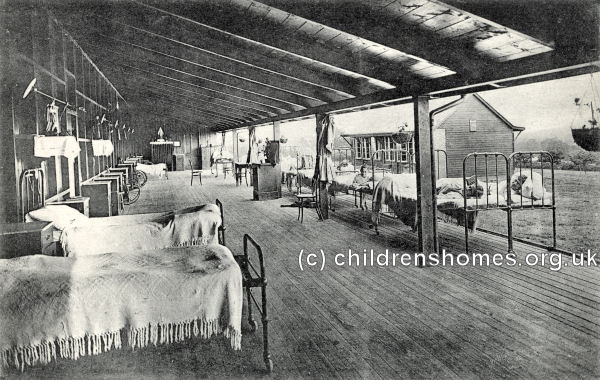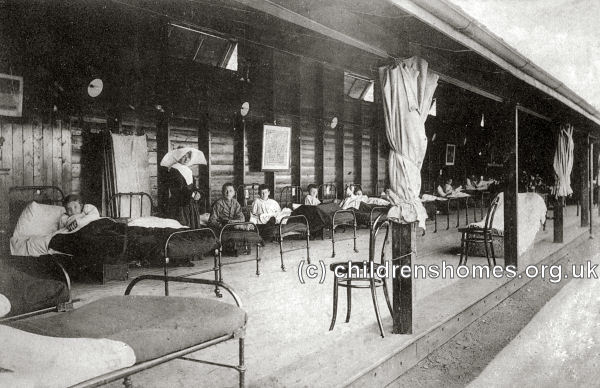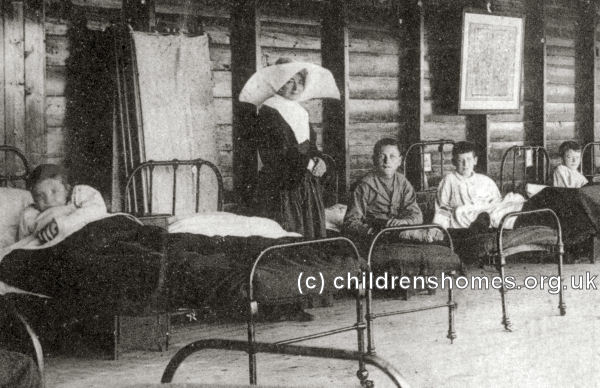St Vincent's Home for Roman Catholic Crippled Boys, Pinner, Middlesex
In 1912, St Vincent's Home for Roman Catholic Crippled Boys moved from its previous location at Clapham Park to new premises at Wiltshire Lane, Eastcote, Pinner, Middlesex. The Home, which was at that time the only one of its kind, had acquired the 25-acre Pinner site the previous year for an expansion of its work. The situation of the property, some 300 feet above sea level, on a south facing hillside, was seen as ideal for this, allowing beds to be placed in open-air wards.

St Vincent's Home for Crippled Boys, Eastcote, Pinner, open-air ward and school building, c.1912. © Peter Higginbotham

St Vincent's Home for Crippled Boys, Eastcote, Pinner, c.1916. © Peter Higginbotham

St Vincent's Home for Crippled Boys, Eastcote, Pinner, c.1916. © Peter Higginbotham
On 31 May 1912, the Home was formally accredited as a Certified School, allowing it to receive boys boarded out by Boards of Guardians, and on June 20th, the premises were certified as Special Industrial School for the accommodation of boys placed under detention by magistrates. Initially, places were available for 105 boys, but this gradually increased as new facilities were constructed. A new Industrial School certificate was issued on 17th July, 1913, increasing the number of places to 110, and another on 2nd February, 1914, taking it 115. As at Clapham Park, the boys were under the care of the Daughters of Charity of St Vincent de Paul. A payment was required for each child of from £75 10s, to £100 a year.
Following an visit to the Home in December, 1914, Mr. W.E. Sparkes, the London County Council's Inspector, reported that:
This fine institution, built on the summit of a hill, about two miles from Pinner Station, and overlooking an open valley, is sympathetically and efficiently controlled by Sisters of Charity.
Some among the inmates are too seriously crippled to be received in the ordinary homes for physically defective children, and the care bestowed on them leaves nothing to be desired.
The completeness of the operating room, as well as the mechanical contrivances about the other rooms for giving relief to the children, may be mentioned as illustrative of the spirit in which the work is carried out in the Home. There is a schoolroom for the stronger boys; the younger are taught, for part of the time at least, while they lie in bed in one of the open-air wards, of which there are four on the estate. The school work is sensibly graded. Simple handwork forms a basis for interest for the younger boys; this develops into wood-carving, boot-making and tailoring among the stronger and older boys. Drawing, nature-walks in the open country round about, and other similar exercises are also included among the school activities. It is evident that the lot of the boys is made as happy as possible through the unceasing care and sympathy of the Sister Superior and her colleagues.
By 1923, the institution had adopted the name St Vincent's Orthopaedic Hospital. In 1925, a ward for 20 girls was opened, with another following in 1930. During the Second World War, war casualties were treated as the Hospital and adults were admitted for the first time.
The Hospital closed in around 2002 and the old buildings were demolished. In July 2006, the new St Vincent's Nursing Home was opened on the site.
Records
Note: many repositories impose a closure period of up to 100 years for records identifying individuals. Before travelling a long distance, always check that the records you want to consult will be available.
- The
Ancestry UK
website has two collections of London workhouse records (both name searchable):
- The Find My Past website has workhouse / poor law records for Westminster.
- London Metropolitan Archives, 40 Northampton Road, London EC1R OHB. Has a few administrative records.
- The National Archives, Kew, Richmond, Surrey, TW9 4DU. Has a few reports and other papers.
- Hillingdon Local Studies, Archives and Museums Service , Central Library, Uxbridge UB8 1HD. Has a Surgery Admissions Register (1963-1972).
Bibliography
- Scott, Jacquie The Hospital on The Hill: A Century of Care — St Vincent's Orthopaedic Hospital Eastcote (2014, The History Press).
- Higginbotham, Peter Children's Homes: A History of Institutional Care for Britain's Young (2017, Pen & Sword)
- Mahood, Linda Policing Gender, Class and Family: Britain, 1850-1940 (1995, Univeristy of Alberta Press)
- Prahms, Wendy Newcastle Ragged and Industrial School (2006, The History Press)
Links
Except where indicated, this page () © Peter Higginbotham. Contents may not be reproduced without permission.


